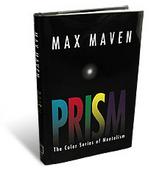Prism
Max Maven
Hermetic Press

While a sizable literature devoted to mentalism was produced in the past hundred years, little has stood the test of time. Among the scant amount that has is that of MAX MAVEN.
Writing under the name of Phil Goldstein, MAVEN has created one of the largest, cleverest and most influential bodies of work in the field, stretching from the latter part of the twentieth century into the twenty-first. His star rose early, with the publication of five slim collections, each packed with innovative and performance-caliber mentalism. These booklets, which have become widely known as "The Color Series," contained items such as "Desire", "The Spirit is Willing (to Write)" and "Four-sided Triangle"—items that have become modern classics in the field.
MAVEN produced the Color booklets in small quantities and, despite ongoing popular request, refused to reprint them. They have become highly sought after, fetching prices in the hundreds of dollars. At last, after a quarter of a century, the entire Color Series is again available; all 53 effects, newly illustrated by Ton Onosaka, 240 pages in hardcover. Welcome to a classic reborn—Prism
Reviews
(Top ▲)
The text is efficient and to-the-point. Instructions are conveyed in a way that is clear and easy to follow. Nevertheless, this is not a book for beginners. The author assumes that the reader is familiar with basic techniques in the field. How to perform a Center Tear, how to false-shuffle a deck, how to force an object using Equivoque—these techniques are not explained in Prism. Aside from typesetting, corrections and credits, and the addition of Ton-san’s lovely drawings, the material has not been updated since its release in the late 1970s. Occasionally, a prop or utility item is mentioned that may be currently off the market. In almost every case, contemporary substitutes and alternative methods can be found.
Max and Stephen are to be commended for making this material accessible to magicians in a way it never was before. Prism is an important book. I imagine that a quarter-century from now, like a stone cast into still waters, it will still be making waves.








